20-minute Full Body Power Band Workout
Power bands are becoming increasingly popular. What are the benefits to using them in your training? Our personal trainer, Jess, discusses and outlines a full-body power band workout.
As the name suggests, power bands add resistance to a movement. They help to train smaller accessory muscles. Strengthening these can boost your strength and improve your sporting performance.
I have put together a 10 step power band workout that will target these smaller muscles. This will build stability and work your core and arms, for a comprehensive full-body workout.
10 Step Power Band Workout
Perform 15-20 reps of each exercise (complete ladder for exercise one) and move onto the next exercise down the list. Have a 2 minute break and repeat. Complete the 10 moves three times.
Do the power band workout 2-3 times per week. You will soon start seeing the benefits of this postural balancing, stabilising, accessory muscle training.
1) Ladder Step Outs
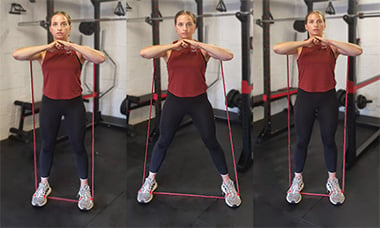
This power band workout move works: Hip abductor muscles, core, and glutes.
How to do ladder step outs:
- Using the power band, step into the band with it under your feet, feet hip width apart.
- Bring the rest of the band up over your arms, hands together in the centre and elbows out horizontally.
- Take lateral strides (side steps) walking out each side in a ladder formation.
- 10 to one side 10 to the other, 9 to one side, 9 to the other, decreasing to zero.
2) Glute Bridges
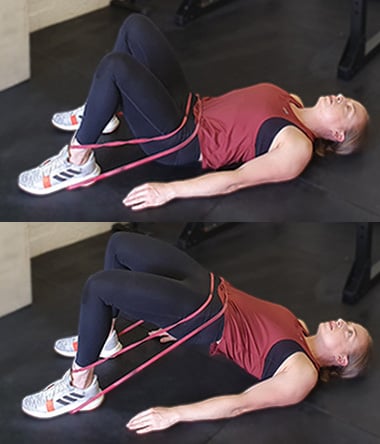
This power band workout move works: Glutes, deep core.
How to do glute bridges:
- Lie on your back, with your knees bent and feet flat on the ground.
- Loop the power band under your right foot.
- Close the band up, bring it up and over your knees onto your hips.
- Loop the other end over your left foot.
- Pushing up through the heel, drive your hips up, with your core engaged.
- Squeeze the glutes as hard as you can at the top.
3) Clams
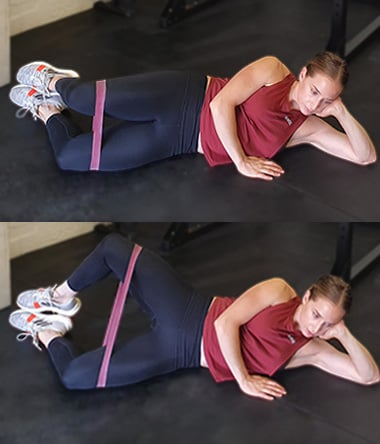
This power band workout move works: Gluteous medius (outer edge of the buttock), pelvic floor.
How to do clams:
- Lie on your side, with your legs inside a mini band, just above the knee.
- Bend your knees, bringing the soles of your feet in line with your buttocks.
- Squeeze the core – tucking in your pelvis.
- Open and shut your knees like a clam shell.
- Pay special attention to squeezing the core and the glute at the outermost extension.
- Repeat the other side.
4) Kick Backs
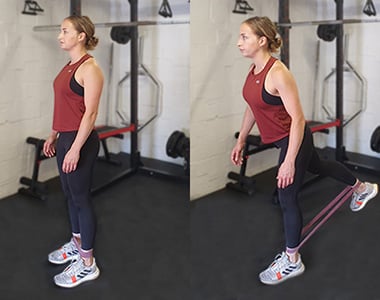
This power band workout move works: Glute, core.
How to do kick backs:
- Stand with a mini band around your calf, just above the ankle.
- Brace the core, hands on hips, or if you need some balance hold onto a wall.
- Swing the left leg back as far as you can – squeeze at the top of the extension.
- Perform 15 reps.
- Move onto the right side.
5) Lying Band Pull Downs
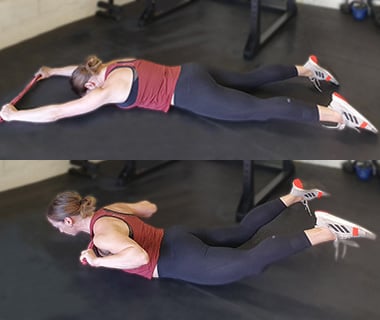
This power band workout move works: Lats, biceps, shoulders.
How to do lying band pull downs:
- Lie on your front.
- Mini band or power band in your hands, hands a shoulder width apart.
- Raise your upper body off the ground while pulling the band down towards your collar bone.
- Squeeze your shoulders back and down.
- Keep your head facing down making sure not to strain the neck.
6) Band Ys
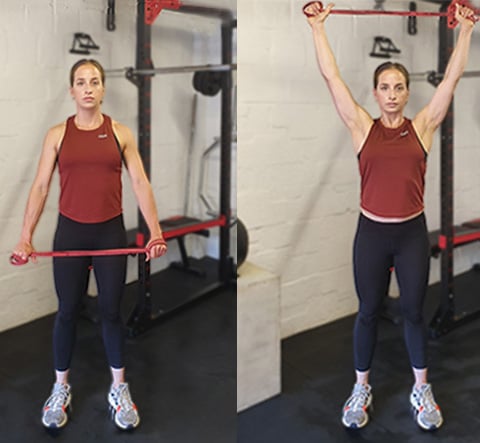
This power band workout move works: Rotator cuff.
How to do band Ys:
- Stand feet hip width apart, pelvis in neutral, core engaged.
- Hold either a mini band or folded power band in between your hands.
- With your arms hanging down, pull your hands apart and raise them up into a Y shape.
- Keep tension and squeeze in the shoulder throughout the motion, as you raise and lower the hands.
- Take time to reset if you need to, really pay attention to your form.
7) Pull Aparts

This power band workout move works: Shoulders (rotator cuff and rear delts), upper back.
How to do pull aparts:
- Stand with feet hip width apart, core engaged, keep your pelvis in neutral.
- Band in your hands, palms facing upwards.
- Raise your arms out in front of you parallel to the ground.
- Reach your arms as far forward as possible, rotating the shoulders forward.
- Pull the band apart, finishing with your arms in a T position, with shoulders and upper back squeezing.
8) Bicep Curls

This power band workout move works: Biceps.
How to do bicep curls:
Using the power band, stand feet hip width apart, inside the band.
Grip the top of the band with both hands.
Hinging at the elbows, use the biceps to squeeze the hands up to your shoulders.
Make sure you keep elbows tucked in and don’t swing with the action.
9) Tricep Kickback

This power band workout move works: Triceps.
How to do tricep kickbacks:
- Lunge forward with your right foot and loop the power band around the front foot.
- Hinge at the hips and lean forward.
- Take a hold of the band with the right hand. Raise the right elbow and extend the hand out backwards in line with the elbow directly out behind you.
- Use controlled movements.
- Make sure the shoulder is pulled back and down.
- Repeat on the left hand side.
10) Oblique Corkscrew
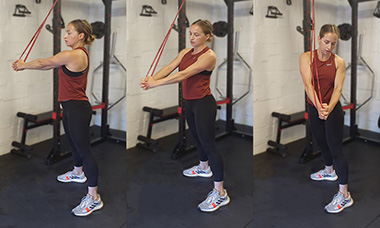
This power band workout move works: Obliques, core.
How to do oblique corkscrews:
- Attach the power power band above you (e.g through a door).
- Stand with the band hanging down above your right shoulder, reach up and take the band in your hands.
- Rotate and contract your abs to bring the right hand down towards the left hip.
- Repeat on the other side.
Benefits of Power Band Workouts
Power band workouts help to train the smaller accessory muscles. These are not traditionally targeted with cardio training such as running or cycling. And they can often be neglected in weight training routines.
The smaller accessory muscles stabilise the hips joints and shoulder joints. Keeping these areas stable is important. They protect against injury, boost strength and enhance performance.
Weakness in the hip and shoulder can play a big part in poor posture. If the hip flexors are tight from cycling a lot, the pelvis can tip forward. This causes weakness in the core. In turn, the scapula in the shoulder rolls forward. This can create tightness in the neck and upper back.
Working these muscles, along with the core, will help to correct poor posture. It activates the glutes, core and rotator cuff muscles. And correctly aligns the pelvis, tightening the core and pulling the shoulder blades back and down.
Other benefits of power band training include:
- Versatile piece of kit that you can take and use anywhere.
- Affordable way to enhance your existing training and prevent injury.
- Great piece of equipment for beginners through to advanced.
- Provide little to no impact or strain on your joints.
- Provide resistance over the whole range of the movement.
Types of Resistance Bands
Resistance bands come in different strengths of elasticity to create varying levels of resistance. You can buy them individually or in packs.
Different types you may have seen:
- Traditional physio strapping – a length of rubber strapping, can be knotted or used as a length.
- Tubed lengths which you can add a handle or strap to.
- Mini bands – smaller resistance bands that go around calves, ankles, thighs or wrists (about 30-40cm diameter).
- Power bands – longer, usually tougher bands about 1.5 meter diameter.
There are benefits to all the different bands, but the most versatile are the power and mini bands.
Buy Resistance Bands Now
The JTX Power Band is a large, robust band that can be used to add resistance to simple exercises. Perfect to strengthen and tone muscles.





